Welcome to the graph paper page at Math-Drills.com where learning can be coordinated in a grid pattern! We have included Graph paper, dot paper, isometric paper and coordinate grid paper in both metric and U.S./Imperial measurements. Graph or grid paper may be used for many purposes such as: graphing, mapping, counting, multiplying, adding, and measuring.
Due to the wide variety of printers, the printable graph paper may or may not print out with precision. In Adobe Reader, change Page Scaling to "None" when printing to get the most precise scaling. You will see this option after you choose to print.
Most Popular Graph Paper this Week
![Four Quadrant Coordinate Graph Paper <i>x</i> = [-10,10]; <i>y</i> = [-12,12] (4 Grids)](https://math-drills.com/graphpaper/images/coordinate_graph_paper_fourquad_1012_fourgrid_inside_300.1692530917.jpg)
![Four Quadrant Coordinate Graph Paper <i>x</i> = [-20,20]; <i>y</i> = [-24,24]](https://math-drills.com/graphpaper/images/coordinate_graph_paper_fourquad_2024_single_inside_300.1692447761.jpg)

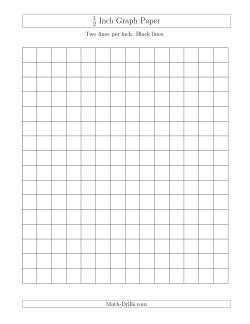
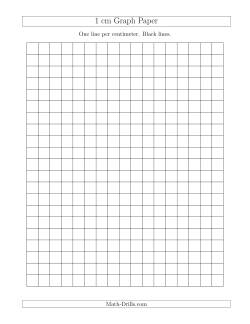
Square Graph Paper

The gray lined graph paper is most useful if you need to draw over top of the existing lines and highlight your own figures. For example, for a measurement lesson, rectangles of different sizes could be outlined in a word problem like the following: "Draw as many rectangles as you can with whole number dimensions that have an area of 36 square centimeters."
This paper uses fractions of inches for those who are used to measuring using the U.S. or Imperial system of measurement. Perhaps you might consider using this graph paper for learning multiplication facts. To multiply 5 by 6, for example, a student would make a rectangle that is five squares by six squares and find out how many squares were contained within. You might also solve a problem like the following using grid paper, "Find the area of forest on a rectangular property that is 9 miles by 7 miles if the entire property is forested except for an estate with a house and open area that is 3 miles by 2 miles."
Multi-line graph paper has many applications including everything that you can accomplish on single-line graph paper. We'll leave the potential to your imagination, but here are a couple ideas to get you started. A three line graph paper worksheet with 2.5 cm, 1.25 cm and 0.25 cm lines ends up having smaller boxes of 25 squares and larger boxes of 100 squares. There are also small rows and columns of 5 squares. This is very similar to the decimal money system that is used in many countries. Therefore, you could model counting coins using this particular three line graph paper. The boxes of 25 and 100 and the rows and columns of 5 make it easy to get a total in the end. Multi-line graph paper also makes most graphing activities easier because students can skip count rather than having to count each line. For example drawing a bar on a bar graph that required a height of 28 would be easier if you had every 4 lines marked with a thicker differently colored line just like you'll find on the two line graph paper with 1 inch major lines and 1/4 inch minor lines.
-
1 inch Major Lines with 1/2 inch Minor Lines 1 inch Major Lines with 1/4 inch Minor Lines 1 inch Major Lines with 1/5 inch Minor Lines 1 inch Major Lines with 1/8 inch Minor Lines 1 inch Major Lines with 1/10 inch Minor Lines 1/2 inch Major Lines with 1/8 inch Minor Lines 1/2 inch Major Lines with 1/4 inch Minor Lines
-
2.5 cm Major Lines with 0.5 cm Minor Lines (A4 Size) 2.5 cm Major Lines with 0.25 cm Minor Lines (A4 Size) 2 cm Major Lines with 0.5 cm Minor Lines (A4 Size) 2 cm Major Lines with 0.25 cm Minor Lines (A4 Size) 1 cm Major Lines with 0.5 cm Minor Lines (A4 Size) 1 cm Major Lines with 0.25 cm Minor Lines (A4 Size)
-
1 inch Major Lines with 1/2 inch Minor Lines (A4 Size) 1 inch Major Lines with 1/4 inch Minor Lines (A4 Size) 1 inch Major Lines with 1/5 inch Minor Lines (A4 Size) 1 inch Major Lines with 1/8 inch Minor Lines (A4 Size) 1 inch Major Lines with 1/10 inch Minor Lines (A4 Size) 1/2 inch Major Lines with 1/8 inch Minor Lines (A4 Size) 1/2 inch Major Lines with 1/4 inch Minor Lines (A4 Size)
Coordinate Graph Paper
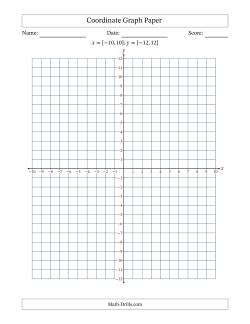
Coordinate graph paper aka coordinate grid paper, Cartesian graph/grid paper or plane paper is used for plotting points in four quadrants on a coordinate plane. It can also be used for transformations that involve more than one quadrant. Many people use it for "Cartesian Art" where students plot points in a given order and join each point to the previous one with a line segment. There are many other uses for coordinate grid paper, limited only by your imagination.
The coordinate graph paper in this section includes all four quadrants in various ranges and there are a few options for multiple grids on each page. The multi-grid versions can save paper when all you need is a small grid for multiple exercises. There are also some versions without axis labels in case you need to use a custom scale.
-
Coordinate Graph Paper x = [-10,10]; y = [-12,12] Coordinate Graph Paper x = [-10,10]; y = [-12,12] (4 Grids) Coordinate Graph Paper x = [-10,10]; y = [-12,12] (9 Grids) Coordinate Graph Paper x = [-20,20]; y = [-24,24] Coordinate Graph Paper x = [-30,30]; y = [-36,36] Coordinate Graph Paper x = [-50,50]; y = [-60,60]
-
Coordinate Graph Paper x = [-10,10]; y = [-12,12] (Axis Labels Outside Grid) Coordinate Graph Paper x = [-10,10]; y = [-12,12] (4 Grids; Axis Labels Outside Grid) Coordinate Graph Paper x = [-10,10]; y = [-12,12] (9 Grids; Axis Labels Outside Grid) Coordinate Graph Paper x = [-20,20]; y = [-24,24] (Axis Labels Outside Grid) Coordinate Graph Paper x = [-30,30]; y = [-36,36] (Axis Labels Outside Grid) Coordinate Graph Paper x = [-50,50]; y = [-60,60] (Axis Labels Outside Grid)
-
Coordinate Graph Paper x = [-10,10]; y = [-12,12] (No Axis Labels) Coordinate Graph Paper x = [-10,10]; y = [-12,12] (4 Grids; No Axis Labels) Coordinate Graph Paper x = [-10,10]; y = [-12,12] (9 Grids; No Axis Labels) Coordinate Graph Paper x = [-20,20]; y = [-24,24] (No Axis Labels) Coordinate Graph Paper x = [-30,30]; y = [-36,36] (No Axis Labels) Coordinate Graph Paper x = [-50,50]; y = [-60,60] (No Axis Labels)
Not everyone is ready for all four quadrants! Learning about coordinate graphs often involves starting with the positive-positive quadrant (i.e. Quadrant I). Many activities are possible using coordinate graph paper, but it is most certainly used for learning how to plot points.
-
Quadrant I (++) Coordinate Graph Paper x = [0,20]; y = [0,24] Quadrant I (++) Coordinate Graph Paper x = [0,20]; y = [0,24] (4 Grids) Quadrant I (++) Coordinate Graph Paper x = [0,20]; y = [0,24] (9 Grids) Quadrant I (++) Coordinate Graph Paper x = [0,30]; y = [0,36] Quadrant I (++) Coordinate Graph Paper x = [0,40]; y = [0,48] Quadrant I (++) Coordinate Graph Paper x = [0,60]; y = [0,72]
-
Quadrant I (++) Coordinate Graph Paper x = [0,20]; y = [0,24] (No Axis Labels) Quadrant I (++) Coordinate Graph Paper x = [0,20]; y = [0,24] (4 Grids) (No Axis Labels) Quadrant I (++) Coordinate Graph Paper x = [0,20]; y = [0,24] (9 Grids) (No Axis Labels) Quadrant I (++) Coordinate Graph Paper x = [0,30]; y = [0,36] (No Axis Labels) Quadrant I (++) Coordinate Graph Paper x = [0,40]; y = [0,48] (No Axis Labels) Quadrant I (++) Coordinate Graph Paper x = [0,60]; y = [0,72] (No Axis Labels)
-
Quadrants I & IV (++ & +-) Coordinate Graph Paper x = [0,20]; y = [-12,12] Quadrants I & IV (++ & +-) Coordinate Graph Paper x = [0,20]; y = [-12,12] (4 Grids) Quadrants I & IV (++ & +-) Coordinate Graph Paper x = [0,20]; y = [-12,12] (9 Grids) Quadrants I & IV (++ & +-) Coordinate Graph Paper x = [0,30]; y = [-18,18] Quadrants I & IV (++ & +-) Coordinate Graph Paper x = [0,40]; y = [-24,24] Quadrants I & IV (++ & +-) Coordinate Graph Paper x = [0,60]; y = [-36,36]
-
Quadrants I & IV (++ & +-) Coordinate Graph Paper x = [0,20]; y = [-12,12] (Axis Labels Outside Grid) Quadrants I & IV (++ & +-) Coordinate Graph Paper x = [0,20]; y = [-12,12] (4 Grids) (Axis Labels Outside Grid) Quadrants I & IV (++ & +-) Coordinate Graph Paper x = [0,20]; y = [-12,12] (9 Grids) (Axis Labels Outside Grid) Quadrants I & IV (++ & +-) Coordinate Graph Paper x = [0,30]; y = [-18,18] (Axis Labels Outside Grid) Quadrants I & IV (++ & +-) Coordinate Graph Paper x = [0,40]; y = [-24,24] (Axis Labels Outside Grid) Quadrants I & IV (++ & +-) Coordinate Graph Paper x = [0,60]; y = [-36,36] (Axis Labels Outside Grid)
-
Quadrants I & IV (++ & +-) Coordinate Graph Paper x = [0,20]; y = [-12,12] (No Axis Labels) Quadrants I & IV (++ & +-) Coordinate Graph Paper x = [0,20]; y = [-12,12] (4 Grids) (No Axis Labels) Quadrants I & IV (++ & +-) Coordinate Graph Paper x = [0,20]; y = [-12,12] (9 Grids) (No Axis Labels) Quadrants I & IV (++ & +-) Coordinate Graph Paper x = [0,30]; y = [-18,18] (No Axis Labels) Quadrants I & IV (++ & +-) Coordinate Graph Paper x = [0,40]; y = [-24,24] (No Axis Labels) Quadrants I & IV (++ & +-) Coordinate Graph Paper x = [0,60]; y = [-36,36] (No Axis Labels)
Square Dot Paper
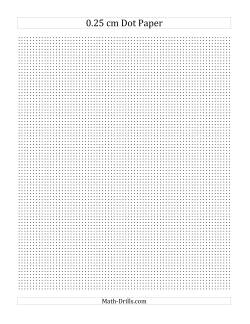
Dot paper can be useful in a variety of mathematical situations. For example, it is quite useful for drawing side views of connecting cube structures or other rectangular based figures. One very interesting use of dot paper is to find the area of irregular polygons using Pick's Formula (named after Georg Alexander Pick). You could decompose an irregular polygon into regular polygons, find the area of each polygon and add the areas, or you could use the much easier Pick's Formula which is to add the number of interior dots to half of the boundary dots and subtract one.
Dot paper can actually be used for just about anything for which grid paper can be used. Dot paper is grid paper without the line segments in between the vertices. Some people prefer dot paper as the page is less busy and allows better definition of anything that is drawn on the page.
Isometric and Hexagonal Paper
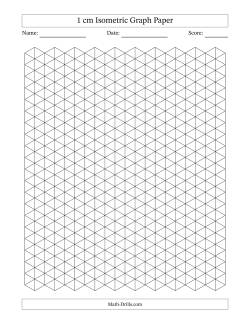
Isometric graph paper has a number of uses, but mainly people use it for drawing in three-dimensions. The lines on the paper go in three directions which correspond to x, y and z axes. Try drawing a cube to see how it works. In math class, teachers might use isometric graph paper for activities related to spatial sense such as drawing rectangular prisms, connecting cube structures, composite 3D figures or the measurement of interiors. More complex drawings are, of course, possible and encouraged. The isometric graph paper comes in two sizes, three colors and two orientations to meet all of your needs.
-
1 cm Isometric Graph Paper (Black) 1 cm Isometric Graph Paper (Gray) 1 cm Isometric Graph Paper With Axes (Gray; One-Octant) 1 cm Isometric Graph Paper With Axes (Gray; Eight-Octant) 1 cm Isometric Graph Paper (Red) 0.5 cm Isometric Graph Paper (Black) 0.5 cm Isometric Graph Paper (Gray) 0.5 cm Isometric Graph Paper With Axes (Gray; One-Octant) 0.5 cm Isometric Graph Paper With Axes (Gray; Eight-Octant) 0.5 cm Isometric Graph Paper (Red)
-
1 cm Isometric Graph Paper (Black; Landscape) 1 cm Isometric Graph Paper (Gray; Landscape) 1 cm Isometric Graph Paper With Axes (Gray; Landscape; One-Octant) 1 cm Isometric Graph Paper With Axes (Gray; Landscape; Eight-Octant) 1 cm Isometric Graph Paper (Red; Landscape) 0.5 cm Isometric Graph Paper (Black; Landscape) 0.5 cm Isometric Graph Paper (Gray; Landscape) 0.5 cm Isometric Graph Paper With Axes (Gray; Landscape; One-Octant) 0.5 cm Isometric Graph Paper With Axes (Gray; Landscape; Eight-Octant) 0.5 cm Isometric Graph Paper (Red; Landscape)
Isometric dot paper is essentially isometric graph paper without the adjoining line segments. With only the vertices on the paper, students drawings are easier to see although maybe their lines won't be as straight. Like the graph paper, the dot paper comes in two sizes, three colors and two orientations.
-
1 cm Isometric Dot Paper (Black) 1 cm Isometric Dot Paper (Gray) 1 cm Isometric Dot Paper With Axes (Gray; One-Octant) 1 cm Isometric Dot Paper With Axes (Gray; Eight-Octant) 1 cm Isometric Dot Paper (Red) 0.5 cm Isometric Dot Paper (Black) 0.5 cm Isometric Dot Paper (Gray) 0.5 cm Isometric Dot Paper With Axes (Gray; One-Octant) 0.5 cm Isometric Dot Paper With Axes (Gray; Eight-Octant) 0.5 cm Isometric Dot Paper (Red)
-
1 cm Isometric Dot Paper (Black; Landscape) 1 cm Isometric Dot Paper (Gray; Landscape) 1 cm Isometric Dot Paper With Axes (Gray; Landscape; One-Octant) 1 cm Isometric Dot Paper With Axes (Gray; Landscape; Eight-Octant) 1 cm Isometric Dot Paper (Red; Landscape) 0.5 cm Isometric Dot Paper (Black; Landscape) 0.5 cm Isometric Dot Paper (Gray; Landscape) 0.5 cm Isometric Dot Paper With Axes (Gray; Landscape; One-Octant) 0.5 cm Isometric Dot Paper With Axes (Gray; Landscape; Eight-Octant) 0.5 cm Isometric Dot Paper (Red; Landscape)
Hexagonal paper is often used in mapping, game design and chemistry. In math class, hexagonal paper can be used for many activities including math games and re-creating Pascal's Triangle.
